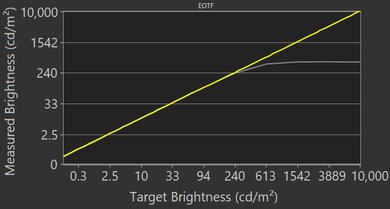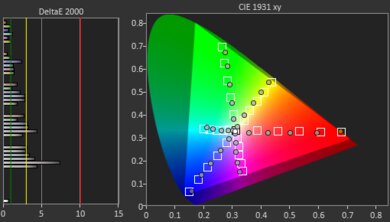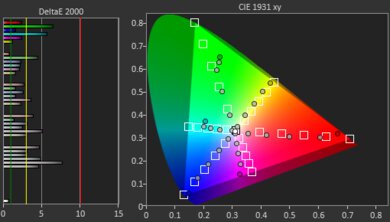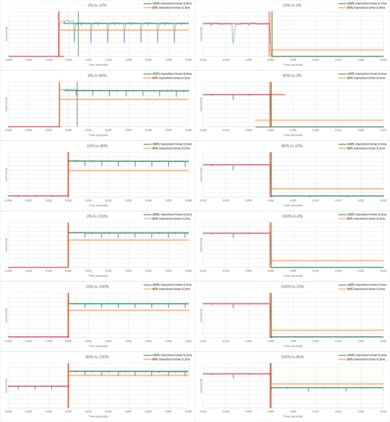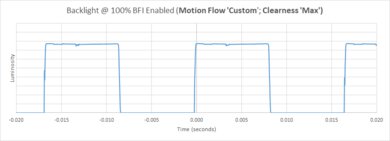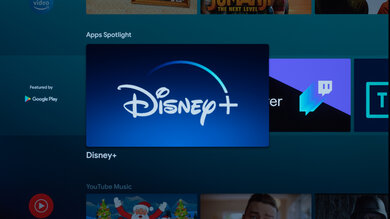The Sony A9S Master Series OLED is an excellent TV that delivers stunning picture quality in almost every type of content. Like all OLEDs, it can produce inky blacks for a great dark room viewing experience. It has a nearly instantaneous response time and an optional Black Frame Insertion feature, resulting in clear motion in fast-moving scenes. Input lag is significantly improved over its predecessor, the Sony A9G OLED, but it still lacks variable refresh rate support. Also, it doesn't have any HDMI 2.1 ports and can't display a 4k @ 120Hz signal, which might disappoint those looking for a TV to go with their PS5 or Xbox Series X. It's been replaced in 2022 by the Sony A90K OLED, which is now available in a 42" and 48" size and features improved gaming features.
Our Verdict
The Sony XBR48A9S is an excellent TV overall. Its OLED panel has a nearly infinite contrast ratio and perfect black uniformity, making it a fantastic choice for watching movies. It's well-suited for watching TV shows or sports as it upscales lower resolution content well, and it has wide viewing angles so that you can watch with a group of people. It has a nearly instantaneous response time and low input lag to deliver an excellent gaming experience; however, it lacks VRR support, and the refresh rate is limited to 60Hz at 4k.
- Inky blacks.
- Near instantaneous response time.
- Exceptional reflection handling.
- Wide viewing angles.
- Risk of permanent burn-in.
- Might not get bright enough to overcome intense glare.
The Sony A9S is exceptional for watching movies. It can produce inky blacks due to its OLED panel's nearly infinite contrast ratio, and there's no blooming around bright objects since there's no backlight, which is great for dark room viewing. It displays lower resolution content well without any artifacts and can remove judder from all sources. Unfortunately, its fast response time causes stuttering in lower frame rate content.
- Inky blacks.
- Perfect black uniformity.
- Removes judder from all sources.
- Stutters in lower frame rate content.
The Sony A9S is great for watching TV shows. It has wide viewing angles, so you don't lose too much image accuracy when viewed from the side, great for those who like to walk around while watching TV. Its Android TV platform is user-friendly and has tons of apps available for download. It has exceptional reflection handling, but it might not get bright enough to overcome intense glare. Unfortunately, it's susceptible to permanent burn-in, especially with static elements like a channel logo.
- Exceptional reflection handling.
- Wide viewing angles.
- Android TV has tons of streaming services.
- Risk of permanent burn-in.
- Might not get bright enough to overcome intense glare.
The Sony A9S is excellent for watching sports. It has a nearly instantaneous response time and a Black Frame Insertion feature, resulting in almost no motion blur in fast-moving scenes. It has wide viewing angles so that images remain accurate when viewed from the side, making it ideal for watching a big game with a big group of people. It handles reflections exceptionally well, but it may struggle to overcome intense glare.
- Near instantaneous response time.
- Exceptional reflection handling.
- Wide viewing angles.
- Risk of permanent burn-in.
- Might not get bright enough to overcome intense glare.
The Sony XBR48A9S is excellent for gaming. It has a quick response time and low input lag to provide a responsive gaming experience. However, it doesn't support any variable refresh rate technology, and the refresh rate is limited to 60Hz at 4k. It has a nearly infinite contrast ratio, making it an ideal choice for those who like gaming in the dark.
- Inky blacks.
- Near instantaneous response time.
- Great input lag.
- Perfect black uniformity.
- No VRR support.
- Risk of permanent burn-in.
The Sony A9S is excellent for watching movies in HDR. It can produce a wide range of colors in HDR content thanks to its excellent color gamut and infinite contrast ratio. However, some highlights don't pop the way they should due to its aggressive Automatic Brightness Limiter. Also, there's some stutter in lower frame rate content. On the upside, there's no blooming around bright objects in dark scenes because it doesn't have a backlight.
- Inky blacks.
- Perfect black uniformity.
- Removes judder from all sources.
- Risk of permanent burn-in.
- Stutters in lower frame rate content.
The Sony A9S is great for gaming in HDR. It has low input lag, and its near-instantaneous response time results in almost no blur trail behind fast-moving objects. Its OLED panel has a nearly infinite contrast ratio to produce perfect blacks, making it a fantastic choice for dark rooms. It has an excellent color gamut for HDR, but it can only bring out highlights in some scenes due to its aggressive Automatic Brightness Limiter.
- Inky blacks.
- Near instantaneous response time.
- Great input lag.
- Perfect black uniformity.
- No VRR support.
- Risk of permanent burn-in.
The Sony A9S is great for use as a PC monitor. It supports most common resolutions and can display proper chroma 4:4:4 for optimal text clarity. It handles reflections well, and it has wide viewing angles so that the image remains accurate at the sides even if you sit up close. Unfortunately, there are risks of permanent burn-in with static elements such as a desktop user interface.
- Near instantaneous response time.
- Great input lag.
- Exceptional reflection handling.
- Wide viewing angles.
- Risk of permanent burn-in.
- Might not get bright enough to overcome intense glare.
Changelog
- Updated Oct 06, 2022: We bought and tested the Sony A90K OLED, and added a few relevant comparisons to this review.
- Updated May 06, 2022: We changed the subtype from WRGB to WOLED as it's more accurate and more consistent with other TVs.
- Updated Aug 04, 2021: Added the real content local dimming videos.
- Updated Apr 29, 2021: Updated the white balance pre-calibration photos.
Check Price
Differences Between Sizes And Variants
We tested the 48 inch Sony A9S OLED (XBR48A9S), and it's the only size available. In Europe and other regions, it's known as the Sony A9 (KD-48A9).
| Size | North America | Europe |
|---|---|---|
| 48" | XBR48A9S | KD-48A9 |
If someone comes across a different type of panel or their Sony A9S doesn't correspond to our review, let us know, and we will update the review. Note that some tests, such as the gray uniformity, may vary between individual units.
Our unit was manufactured in October 2020; you can see the label here.
Popular TV Comparisons
The Sony A9S is an excellent TV overall and delivers fantastic picture quality for nearly every type of content. However, it's very expensive for a 48" TV, and it lacks features such as HDMI 2.1 ports and VRR support that other high-end TVs have, like the LG CX OLED. For other options, check out our recommendations for the best OLED TVs, the best 48-49-50 Inch TVs, and the best TVs for watching movies.
The Sony A90K OLED is the replacement for the Sony A9S OLED. The A9S is a bit brighter, so it can handle more glare overall, but the A90K has better gaming features. The A90K supports variable refresh rate technology and supports HDMI 2.1 bandwidth over two of its HDMI ports, allowing for 4k @ 120Hz gaming from the Xbox Series S|X or the PS5.
The Sony A9S OLED and the Sony A9G OLED are almost identical. The most notable change is the A9S' significantly lower input lag. The A9S also has better accuracy out of the box, and its Black Frame Insertion feature can flicker at 120Hz for 120fps content. The A9G has slightly better viewing angles, and its Automatic Brightness Limiter isn't as aggressive, so the overall brightness is more consistent.
The Sony A9S OLED and the Sony A8H OLED are nearly identical. The main differences are that the A8H's SDR peak brightness is more consistent due to a less aggressive ABL, and it has better accuracy out of the box. The A8H is only available in a 55 inch or 65 inch, while the A9S is only available in a 48 inch.
The LG CX OLED and the Sony A9S OLED are very much alike, but the LG is a bit better, mainly due to its advanced gaming features. It can display a 4k @ 120Hz signal, and it has lower input lag and VRR support. The Sony's viewing angles are slightly wider, making it a better choice for wide seating areas. It has better gray uniformity as well; however, this varies between units.

We buy and test dozens of TVs yearly, taking an objective, data-driven approach to deliver results you can trust. Our testing process is complex, with hundreds of individual tests that take over a week to complete. Most of our tests are done with specially designed test patterns that mimic real content, but we also use the same sources you have at home to ensure our results match the real-world experience. We use two main tools for our testing: a Colorimetry Research CR-100 colorimeter and a CR-250 spectroradiometer.
Test Results

The Sony XBR48A9S has a simple and minimalist design that looks almost identical to the Sony A9G OLED. The borders are thin on all sides, and it has a center-mounted stand that sits very low, which might be a problem if you have a soundbar placed in front.
The back of the TV is plain except for a few airflow vents. The bottom panel is removable, allowing you to guide all the cables towards a small cutout in the stand for cable management.
The build quality is exceptional, almost identical to the Sony A8H OLED. It's made of a mix of plastic and metal, feels very sturdy, and there are no obvious gaps. There's a little bit of flex on the back panel near the sides, but nothing that should cause concern.
The Sony A9S has a mediocre SDR peak brightness. It varies a lot depending on the scene due to its aggressive Automatic Brightness Limiter (ABL), and it gets dimmer as larger areas of the screen light up. Visibility shouldn't be an issue in most lighting conditions, but it might not be bright enough to overcome intense glare. Similar to the Sony A8H OLED, the brightness ramps up and drops back down once it reaches its peak in the 2% and 10% windows, although not by much.
We measured the SDR peak brightness after calibration in the 'Custom' Picture Mode, with Color Temperature set to 'Expert 1' and Peak Luminance set to 'High'.
If you don't mind losing image accuracy, you can get a brighter image in the 'Vivid' Picture Mode with all other settings at their default value. We achieved a peak of 668 cd/m² with these settings.
Update 08/04/2021: Added the real content local dimming videos.
The Sony A9S can turn individual pixels on/off and doesn't require a backlight, just like all OLEDs. This means it can reach perfect black levels without any blooming around bright objects.
Update 08/04/2021: Added the real content local dimming videos.
The HDR peak brightness is okay, almost identical to the Sony A8H OLED. Just like in SDR, the ABL causes the brightness to vary significantly depending on the content. It's bright enough to bring out some highlights, especially in darker scenes. Again, the brightness in the 2% and 10% windows drops slightly after reaching its peak.
We measured the HDR peak brightness before calibration in the 'Custom' Picture Mode with Brightness set to max, Contrast at '90', and Color Temperature set to 'Expert 1'.
If you don't mind losing accuracy, you can get a brighter image in the 'Vivid' Picture Mode with Peak Brightness set to 'High', Contrast Enhancer set to 'Off', and the remaining settings at their default value. We can achieve a peak of 836 cd/m² with these settings; however, it takes between 30 to 60 seconds to ramp up the brightness from 760 cd/m² to 836 cd/m².
Gray uniformity is excellent. There's almost no noticeable dirty screen effect, which is great for sports fans. Uniformity in dark scenes is better, and we didn't see any faint horizontal or vertical lines, although this can happen with more extensive use. Note that gray uniformity varies between individual units.
Update 04/29/2021: We uploaded new photos because the old white balance photo was incorrect. The picture showed 20-point white balance when it's in fact 10-point. This doesn't change the results.
The accuracy is great out of the box; however, this can vary between units. Most colors and white balance are only slightly off. Gamma is nearly perfect, so most scenes appear at the correct brightness. The color temperature is much colder than our 6500k target, resulting in a blueish tint.
Accuracy is exceptional after calibration. Most colors and white balance are nearly perfect, and the color temperature is much closer to our 6500k target. Gamma is still excellent, but some scenes are slightly too bright.
You can see our recommended settings here.
Like all OLEDs, the Sony A9S uses an RGBW sub-pixel structure. They're never all on at the same time; you can see the green sub-pixel in this photo.
The Sony A9S has an excellent color gamut. It has near full coverage of the DCI P3 color space used in most HDR content and decent coverage of the wider Rec. 2020. The EOTF follows the PQ curve perfectly until its roll-off, and it's almost identical in Game mode. If you find HDR content too dim, you can get a brighter image by setting Advanced Contrast Enhancer and Peak Brightness to 'High', with Brightness and Contrast at max. These settings result in a much brighter image, as you can see in this EOTF.
The Sony A9S has outstanding gradient handling. There's a tiny amount of banding in most colors, and it's most visible in the grays and greens. Setting Smooth Gradation to 'Low' doesn't seem to do much. The 'Medium' and 'High' settings do a good job of removing most banding but might cause a loss of fine details in some scenes.
There's some image retention right after exposing a high-contrast image for 10 minutes; however, it dissipates within a few minutes. Note that image retention can vary between individual units.
Like all OLEDs, the Sony A9S is susceptible to permanent burn-in, which happens when static elements stay on the screen for an extended period, like a channel logo or a desktop user interface. However, we don't expect it to be an issue for most people who watch varied content, and there are also features built-in to minimize the risks, such as Pixel Shift and Panel Refresh. You can read more about it here.
Update 01/11/2021: We've retested the BFI and can confirm that the backlight flickers at 96Hz in 24p content when the Clearness slider is set to '1' or '2', and 48Hz when it's set to '3'. This is the same behavior that we noticed on the Sony A8H OLED and Sony A9G OLED.
The Sony A9S has an optional Black Frame Insertion feature that can further reduce motion blur. To use BFI, enable MotionFlow, then set Clearness to '3' for 60fps content, and '1' or '2' for 120fps content. Using BFI improves image clarity, but it results in a noticeably dimmer image.
The Sony A9S can interpolate lower frame rate content up to 120fps to make motion look smoother, also known as the 'Soap Opera' effect. It performs well for the most part, but there are some artifacts in busier scenes. To use it, set Cinemotion to 'Auto' and Smoothness to max.
Due to the Sony A9S' near-instantaneous response time, lower frame rate content can appear to stutter. If it bothers you, enabling motion interpolation can help.
The Sony A9S can remove judder from all sources. You don't need to change any settings for 24p content, but it's better to set Cinemotion to 'Auto' as leaving it at 'Off' causes a few frames to be out of place. To remove judder from 24p content via native apps and 60i/p content, set Cinemotion to 'Auto' and Motionflow to 'Custom', but leave the Smoothness setting at '0'.
The Sony A9S doesn't support any variable refresh rate technology to reduce screen tearing when gaming.
Update 01/11/2021: We've retested the Auto Picture Mode setting. When enabled, it recognizes the PS5 as a gaming console and switches to 'Game' mode automatically. However, it doesn't work at all with the Xbox One X or Xbox Series X. This means that the Auto Picture Mode only works with compatible devices, same as with the universal remote feature.
The Sony A9S' input lag is great, almost identical to the Sony A8H OLED. It's slightly higher than most recent high-end 4k TVs, but it should be low enough for casual gaming and desktop use. To get the lowest latency, you can use either the 'Game' or 'Graphics' Picture Mode.
The Sony A9S supports most common resolutions. However, 1440p @ 60Hz only works if you set the screen setting to 'Wide' and 1440p @ 120Hz skips frames. Unfortunately, it can't display a 4k @ 120Hz signal. It can display proper chroma 4:4:4 at all supported resolutions for optimal text clarity when using the TV as a PC monitor. To display chroma 4:4:4, set the HDMI Signal Format to 'Enhanced format' for the input in use, and you have to be either in the 'Game' or 'Graphics' Picture Mode. For signals that require the full HDMI 2.0's bandwidth, you also need to set the HDMI Signal Format to 'Enhanced format' for the input in use.
The Sony A9S OLED can't take full advantage of the PS5 or Xbox Series S|X, as its HDMI ports lack the bandwidth necessary for 4k @ 120Hz gaming. The replacement model, the Sony A90K OLED, supports HDMI 2.1 bandwidth on two of its HDMI ports, and it has much better compatibility with both consoles.
The Sony A9S supports eARC even though it doesn't have an HDMI 2.1 port. This allows the TV to pass high-quality audio such as Dolby Atmos via TrueHD to an external device over an HDMI connection. To use it, set eARC to 'Auto', Digital Audio Out to 'Auto 1', and Passthrough to 'Auto'.
The Sony A9S has a good frequency response. It's well-balanced, but there's a lack of low-bass, so it can't produce a deep, rumbling sound. It gets pretty loud without adding much compression artifacts, great for large or noisy environments.
The distortion performance is mediocre. There's minimal distortion at moderate volume levels, but it increases significantly as the volume nears max. That said, it depends on the content, and most people might not hear it.
The remote control is the same as the Sony A8H OLED's but in a silver color with a brushed finish. There are quick-access buttons to Google Play and Netflix, and there's a dedicated button to summon the Google Assistant. You can use voice control to search for content and get information such as the current weather and time. You can change things like the volume and input source using voice control, but not settings such as the brightness.









